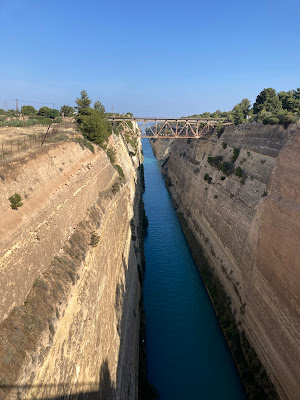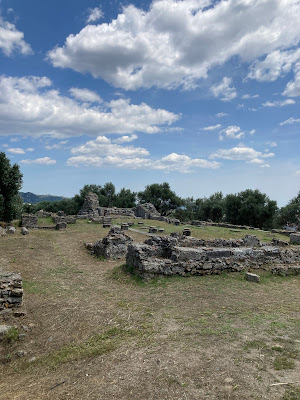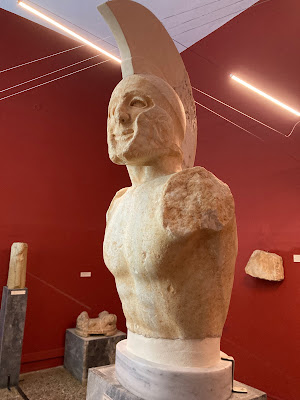When we first talked about going to Greece, my first immediate question was if we could go to Sparta.
I asked this knowing that the answer was likely no - the actual ruins of Sparta are pretty sparse and pale in comparison to what remains in Athens - even the Greeks of the Classic period commented that it would be hard to believe for future generations to believe that the location of Sparta had ever been as significant as it was because there was nothing like what one saw in Athens - for example, in the Archaic and Classical period there was never a wall around Sparta like virtually every other Greek city - as Thucydides said:
"Suppose, for example, that the city of Sparta were to become deserted and that only the temples and foundations of buildings remained. I think that future generations would, as time passed, find it very difficult to believe that this place had really been as powerful as it was represented to be...Since, however, the city is not regularly planned and contains no temples or monument of great magnificence, but is simply a collection of villages, in the ancient Hellenic way, its appearance would not come up to expectation."
Beyond a dearth of things to see, there is the simple fact that it is three hours south of Athens in the Peloponnese, a city on the side of the road between other places. One does not, I suspect, "go" to Sparta unless one has a real reason for doing so.
In a gift of great kindness, The Ravishing Mrs. TB paid for a tour and so Nighean Dhonn and myself got up early one morning for a day tour.
In going to Sparta, one has to pass the Isthmus of Corinth. The isthmus is 6.3 miles/3.9 kilometers at its narrowest point. Control of the Isthmus is what brought great wealth to the city of Corinth. At one time, cargo and ships could be tran-shipped over the Isthmus by the Diolkos, a stone pathway 2hich may have used a wheeled cart. The canal was finally dug and finished in 1893 - it is only 80 feet/24 m wide and around 21 feet/7 meters deep, and so really is only used for smaller boats at this point.
Unlike the Acropolis of Athens, Ancient Sparta is not teeming with tourists: it almost reminds one of a regional park. There is no fee for entrance and beyond ourselves, there were likely not half a dozen people there, including park personnel. Like many sites, it is a hodgepodge of ruins from various periods.
Below are the ruins of "The Round Building". There are no firm conclusions on what this was; the blocks are from the Roman Restoration in the early 1st Century A.D.
In the end, Thucydides' was correct: The ruins of Sparta hardly demonstrate any sort of powerful city state at all, and belie the fact that it was one of the most powerful for almost 300 years.



















.jpg)




For not having much to see, Sparta certainly has a lot to see!
ReplyDeleteI'm guessing Thucydides' statement would be appropriate for quite a few places. Power can certainly be demonstrated through architecture, but I suspect it evidenced mostly by the dynamic of the rulers and the people.
Leigh, it is a funny thing: were this a North American country and we had these sorts of ruins at all, it would have been amazing. I think they get buried beneath the fact that there is so much - and in so much better shape - in Greece.
DeleteI suspect that you are right. We connect power through physical presence and remnants, but plenty of cultures throughout history have exercised immense power and left very little behind - the Steppe cultures in particular come to mind.
I agree. Plenty to see. And the imagination can wonder at the unidentified buildings. :)
ReplyDeleteThanks for this post, TB.
You all be safe and God bless.
Linda, one really does have to use one's imagination and the existing literature to see this places in our mind's eye in all of their glory. And you are, of course, quite welcome.
DeleteA day tour well worth the drachmas TB. Lots of mountains and few visitors indeed! Well done on the photos.
ReplyDeleteThanks Nylon12. This honestly was one of the high points of the trip for me. I have spent so many years reading about Sparta that to finally be able to go and see - even with what was there - was wish come true.
DeleteI am amazed that these ancient civilizations spent so much time on building structures so strongly made. I wonder how much time it took to build the average Greek home.
ReplyDeleteThey certainly built things to last. Also, perhaps stone as a building material is far more permanent - we lack similar larger structures overall (generally) because wood rots far more quickly.
DeleteI suspect that ancient stonemasons at the peak of the craft could erect a structure in what would seem a shockingly short amount of time to us in the modern day.
Sparta hadn't crossed my mind but when I saw the title of your post, I was excited at the possibilities. That changed over course when I actually read your post and learned that there isn't much left. I wouldn't have guessed that. Still, the lack of crowds makes me ponder it in my immediate future.
ReplyDeleteEd, we actually did a tour that drove to Sparta and the fortress city of Mystras (post coming soon). I actually really enjoyed this day, both for the historical aspect as well as the fact that it was not as well traveled to so there was a great deal of opportunities to really "see" things.
Delete